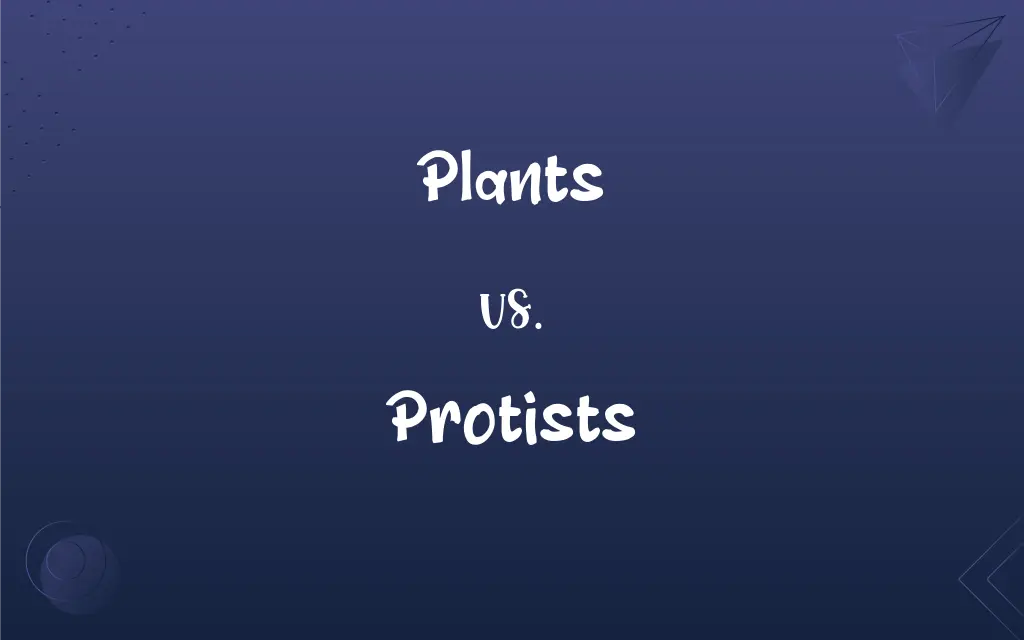Plants vs. Protists: What's the Difference?
Edited by Aimie Carlson || By Harlon Moss || Updated on October 26, 2023
Plants are multicellular organisms that photosynthesize, while protists are diverse, mostly unicellular organisms that can be photosynthetic, heterotrophic, or mixotrophic.

Key Differences
Plants are multicellular and primarily obtain energy through photosynthesis, while protists are mostly unicellular and can be photosynthetic, heterotrophic, or mixotrophic.
In terms of cellular structure, plant cells have rigid cell walls made of cellulose, while protist cells may have diverse cell structures, some with flexible cell walls or no cell walls at all.
Plants are predominantly terrestrial and have specialized organs like roots, stems, and leaves. Protists, in contrast, are primarily aquatic and lack such specialized structures.
Reproduction in plants is often sexual and can be asexual; it involves complex life cycles. Protists exhibit a variety of reproductive methods, ranging from simple asexual division to complex life cycles involving multiple hosts.
Plants form an integral part of the ecosystem as primary producers. Protists play diverse roles, including primary producers, decomposers, and parasites in various ecosystems.
ADVERTISEMENT
Comparison Chart
Cellularity
Multicellular
Mostly unicellular
Cell Structure
Rigid cell walls made of cellulose
Varied cell structures
Habitat
Predominantly terrestrial
Primarily aquatic
Specialized Organs
Have roots, stems, leaves
Lack specialized structures
Role in Ecosystem
Primary producers
Diverse roles including producers, parasites
ADVERTISEMENT
Plants and Protists Definitions
Plants
Multicellular organisms that photosynthesize.
The oak tree is a plant that provides shade and oxygen.
Protists
Mostly unicellular, diverse organisms.
The amoeba is a protist found in pond water.
Plants
Terrestrial primary producers with specialized organs.
This plant’s roots absorb water and nutrients from the soil.
Protists
Aquatic organisms with diverse roles.
Algae, a photosynthetic protist, produces oxygen in oceans.
Plants
Organisms with complex reproductive cycles.
The flowering plant reproduces through pollination.
Protists
Organisms with varied reproductive methods.
Some protists reproduce quickly through binary fission.
Plants
Organisms with cellulose-based cell walls.
The plant’s sturdy cell wall provides structural support.
Protists
Can be photosynthetic, heterotrophic, or mixotrophic.
This protist can photosynthesize and consume other organisms.
Plants
Key components of terrestrial ecosystems.
Plants in the rainforest create a vital habitat for wildlife.
Protists
Organisms with varied cell structures.
This protist’s flexible membrane allows it to change shape.
Plants
Any of various photosynthetic, eukaryotic, multicellular organisms of the kingdom Plantae characteristically containing chloroplasts, having cell walls made of cellulose, producing embryos, and lacking the power of locomotion. Plants include trees, bushes, herbs, ferns, mosses, and certain green algae.
Protists
Any of numerous eukaryotic organisms that are not fungi, plants, or animals and are chiefly unicellular or colonial. Protists that are multicellular do not have cells differentiated into tissues. The protists include the protozoans, certain algae, oomycetes, and slime molds.
Protists
Plural of protist
FAQs
Can protists be multicellular?
While most are unicellular, some protists can form multicellular colonies.
What are plants?
Multicellular organisms that primarily photosynthesize.
Are protists mostly aquatic?
Yes, protists predominantly inhabit aquatic environments.
Do plants have a rigid cell structure?
Yes, plant cells have rigid cell walls made of cellulose.
Are protists diverse in their nutritional modes?
Yes, they can be photosynthetic, heterotrophic, or mixotrophic.
Are protists found in soil?
Yes, some protists inhabit soil and contribute to nutrient cycling.
Do protists have a role in aquatic food chains?
Yes, especially photosynthetic protists like algae, which are primary producers.
Are all protists microscopic?
Many are microscopic, but some, like certain algae, are visible to the naked eye
What are protists?
Diverse, mostly unicellular organisms with various nutritional modes.
How do plants reproduce?
Plants reproduce sexually, often involving flowers and seeds, and can also reproduce asexually.
Do plants play a role in oxygen production?
Yes, through photosynthesis, plants produce oxygen.
Can plants be found in diverse environments?
Yes, plants have adapted to a wide range of terrestrial environments.
Can plants live in aquatic environments?
Some plants are aquatic, but most are terrestrial.
Can protists be parasitic?
Yes, some protists are parasites, causing diseases in hosts.
Do plants form an essential part of the carbon cycle?
Yes, through photosynthesis and respiration, plants are integral to the carbon cycle.
Do plants have specialized organs?
Yes, plants have roots, stems, leaves, and other specialized structures.
Are protists important in ecosystems?
Yes, they play diverse roles, including as primary producers and decomposers.
How do protists reproduce?
Protists exhibit diverse reproduction methods, from simple asexual division to complex cycles.
Are plants a key part of terrestrial ecosystems?
Yes, they are primary producers and form the basis of many food chains.
Can protists form colonies?
Some protists can aggregate to form multicellular-like colonies.
About Author
Written by
Harlon MossHarlon is a seasoned quality moderator and accomplished content writer for Difference Wiki. An alumnus of the prestigious University of California, he earned his degree in Computer Science. Leveraging his academic background, Harlon brings a meticulous and informed perspective to his work, ensuring content accuracy and excellence.
Edited by
Aimie CarlsonAimie Carlson, holding a master's degree in English literature, is a fervent English language enthusiast. She lends her writing talents to Difference Wiki, a prominent website that specializes in comparisons, offering readers insightful analyses that both captivate and inform.































































